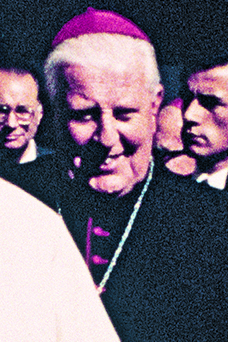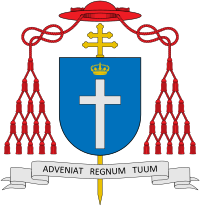Juan Francisco Fresno facts for kids
Quick facts for kids Juan Francisco Fresno Larraín |
|
|---|---|
| Archbishop Emeritus of Santiago | |

The cardinal in 1987 during the papal visit to Chile.
|
|
| Church | Roman Catholic Church |
| Archdiocese | Santiago |
| See | Santiago |
| Appointed | 3 May 1983 |
| Enthroned | 10 June 1983 |
| Reign ended | 30 March 1990 |
| Predecessor | Raúl Silva Henríquez |
| Successor | Carlos Oviedo Cavada |
| Other posts | Cardinal-Priest of Santa Maria Immacolata di Lourdes a Boccea (1985–2004) |
| Orders | |
| Ordination | 18 December 1937 |
| Consecration | 15 August 1958 by Alfredo Cifuentes Gómez |
| Created Cardinal | 25 May 1985 |
| Rank | Cardinal-Priest |
| Personal details | |
| Birth name | Juan Francisco Fresno Larraín |
| Born | 26 July 1914 Santiago, Chile |
| Died | 14 October 2004 (aged 90) Santiago, Chile |
| Buried | Santiago Cathedral |
| Parents | Luis Alfredo Fresno Ingunza Elena Larraín Hurtado |
| Previous post |
|
| Alma mater |
|
| Motto | Adveniat regnum Tuum |
| Coat of arms |  |
| Styles of Juan Francisco Fresno Larraín |
|
|---|---|
 |
|
| Reference style | His Eminence |
| Spoken style | Your Eminence |
| Informal style | Cardinal |
| See | Santiago de Chile |
Juan Francisco Fresno Larraín (born July 26, 1914 – died October 14, 2004) was an important leader in the Roman Catholic Church in Chile. He became a Cardinal in 1985. From 1983 to 1990, he served as the Archbishop of Santiago, which is a very high position.
Contents
Early Life and Education
Juan Francisco Fresno Larraín was born in Santiago de Chile. His parents were Luis Alfredo Fresno Ingunza and Elena Larraín Hurtado. He studied to become a priest at a special school in Santiago. He also went to the Pontifical Gregorian University in Rome, Italy. There, he earned a special degree in theology, which is the study of religious faith.
Becoming a Priest and Bishop
On December 18, 1937, Juan Francisco became a priest. This ceremony took place at the cathedral in Santiago. For many years, from 1937 to 1958, he worked as a pastor. He also helped guide young students at a seminary.
In 1958, Pope Pius XII chose him to be the Bishop of Copiapó. A bishop is a high-ranking church leader who oversees a group of churches. He also attended the Second Vatican Council, which was a very important meeting for the Catholic Church worldwide. Later, in 1971, Pope Paul VI made him the Archbishop of La Serena. An archbishop leads a larger group of churches called an archdiocese.
Leading the Church in Chile
In 1975, Juan Francisco Fresno Larraín was chosen to be the President of the Episcopal Conference of Chile. This meant he was the main leader for all the Catholic bishops in Chile.
Working for Democracy
During a difficult time in Chile, when the country was under military rule, he played a very important role. He worked to help bring democracy back to Chile. He talked to different groups of people who wanted to see democracy return. He helped them come together and work as one team. This was a big step because these groups had not always agreed with each other.
Cardinal Fresno helped these groups start talking to the government. His efforts led to a special agreement called the "National Agreement for the Transition to Full Democracy." This agreement was very important. It helped set the stage for a national vote in 1988. This vote marked the beginning of the end of military rule in Chile.
Becoming a Cardinal
On May 3, 1983, Pope John Paul II appointed Juan Francisco Fresno Larraín as the Archbishop of Santiago de Chile. This is one of the most important church positions in Chile.
Then, on May 25, 1985, Pope John Paul II made him a Cardinal. Cardinals are very important advisors to the Pope. They also help choose the next Pope. He was given the title of Cardinal-Priest of Santa Maria Immacolata di Lourdes a Boccea.
In 1990, he stepped down from his role as Archbishop of Santiago. When he turned 80 years old in 1994, he could no longer take part in choosing a new Pope.
See also
 In Spanish: Juan Francisco Fresno para niños
In Spanish: Juan Francisco Fresno para niños

